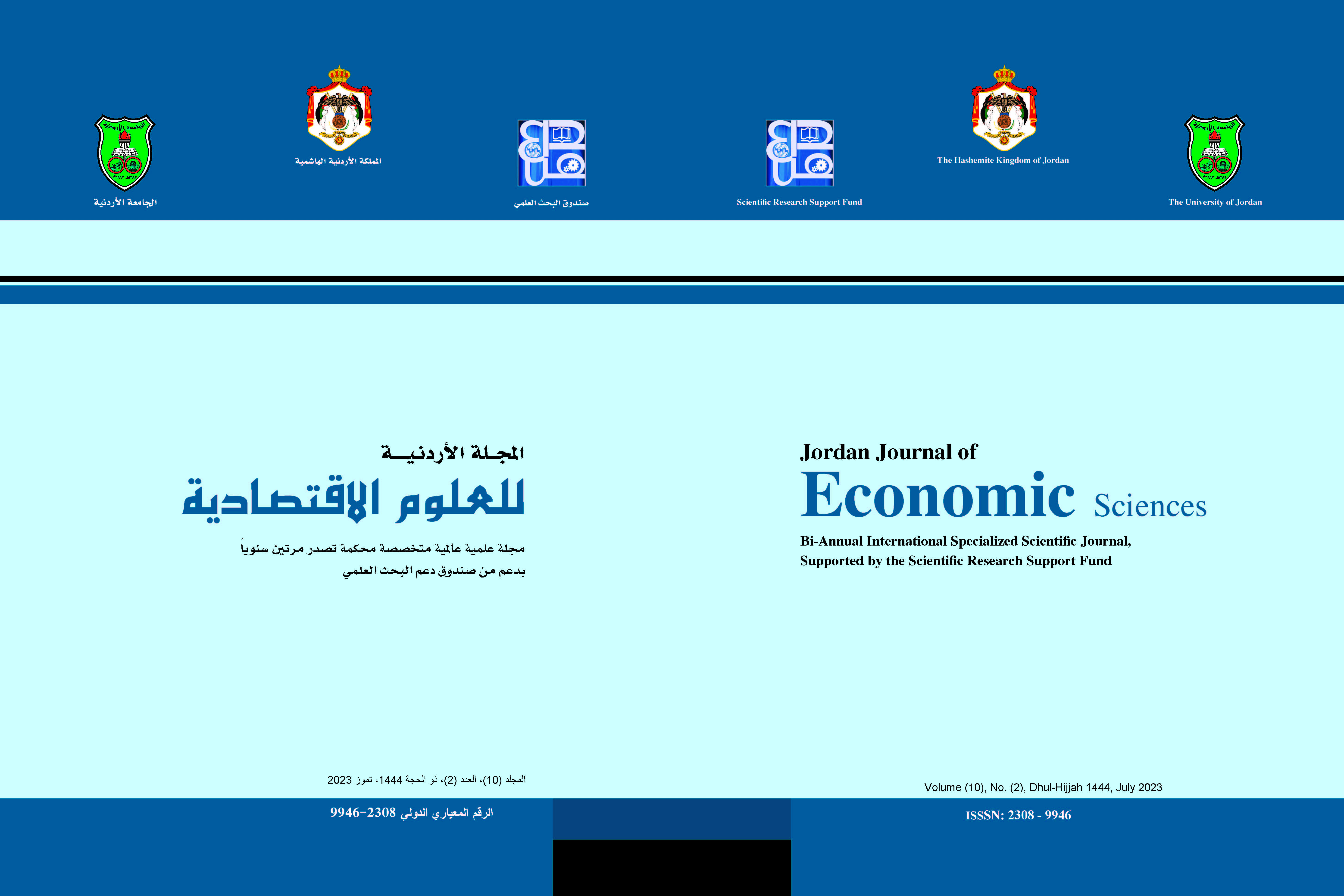The Infrastructure and Foreign Direct Investment: The Case of Selected Arab Countries
DOI:
https://doi.org/10.35516/jjes.v10i2.1403Keywords:
Foreign Direct Investment, Infrastructure, Arab countriesAbstract
Objectives: This study aims to investigate the role of infrastructure in attracting foreign direct investment in selected Arab countries during the period 2007-2019 using annual data. The sample of the study utilizes panel data representing thirteen countries of the Arab region.
Methods: The study employs the ordinary least square (OLS) regression model to analyze the panel data. The study model includes the infrastructure index, trade openness, real GDP growth, and the corruption index as independent variables. At the same time, the net flow of foreign direct investment has been identified as a dependent variable.
Results: The study’s results indicate a direct and statistically significant relationship between infrastructure, GDP growth, and trade openness to FDI flows, while the results indicate a statistically significant inverse relationship between the corruption index to the selected Arab countries.
Conclusions: The study’s variables may be considered important determinants for attracting foreign capital represented by foreign direct investment. Furthermore, Arab countries still need more projects to improve infrastructure quality.
References
Ahmad, N., Ismail, N., Nordin, N. (2015). The Impact of Infrastructure on Foreign Direct Investment in Malaysia. International Journal of Management Excellence, 5(1), 584-590.
Asteriou, D., & Hall, S. G. (2007). Applied Econometrics: a modern approach, revised edition. Hampshire: Palgrave Macmillan, 46(2), 117-155.
Baltagi, Badi H. (2005).” Econometric Analysis of Panel Data”, E-book, 4th edition, John Wiley & Sons TNC. New York. USA.
Castro, C., & Nunes, P. (2013). Does corruption inhibit foreign direct investment?. Política. Revista de Ciencia Política, 51(1), 61-83.
De Hoyos, R. E., & Sarafidis, V. (2006). Testing for cross-sectional dependence in panel-data models. The stata journal, 6(4), 482-496.
International Monetary Fund (2004). Direct investment: 10 percent threshold of voting power/equity ownership, employment. OUTCOME PAPER (DITEG) # 2, Seventeenth Meeting of the IMF Committee on Balance of Payments Statistics Pretoria, October 26–29, 2004, BOPCOM-04/31. Available at: https://www.imf.org/external/pubs/ft/bop/2004/04-31.pdf.
Khadaroo, A. J., & Seetanah, B. (2010). Transport Infrastructure and Foreign Direct Investment. Journal of International Development: The Journal of the Development Studies Association, 22(1), 103-123.
Khadaroo, J., & Seetanah, B. (2009). The Role of Transport Infrastructure in FDI: Evidence from Africa Using GMM Estimates. Journal of Transport Economics and Policy (JTEP), 43(3), 365-384.
Mat, S. H. C., & Harun, M. (2012). The Impact of Infrastructure on Foreign Direct Investment: The case of Malaysia. Procedia-Social and Behavioral Sciences, 65, 205-211.
Mjacu, L. (2018). The Role of Transport Infrastructure in Attracting Foreign Direct Investment in South Africa. Euro Economica, 37(03), 140-148.
Preepremmote, P., Phukseng, T., Sangwan, T. (2020). Information and Communication Technology, Transportation Infrastructure, and their Effect on Inward Foreign Direct Investment in the ASEAN. Editorial Board, 335.
Quazi, R., Vemuri, V., & Soliman, M. (2014). Impact of corruption on foreign direct investment in Africa. International Business Research, 7(4), 1-10.
Rangkakulnuwat, P., & Paweenawat, S. W. (2015). The Determinants of Foreign Direct Investment in ASEAN. International Journal of Social Economics, 42(3), 239-250.
Rehman, C. A., Ilyas, M., Alam, H. M., Akram, M. (2011). The Impact of Infrastructure on Foreign Direct Investment: The Case of Pakistan. International Journal of Business and Management, 6(5), 268-276.
Shah, M. H. (2014). The Significance of Infrastructure for FDI Inflow in Developing Countries. Journal of Life Economics, 1(2), 1-16.
The World Bank Group. Database. Available at: https://www.worldbank.org/
The World Economic Forum (WEF). Competitiveness reports (2007-2019). Available at: https://www.weforum.org/
Transparency International Organization. Corruption Perceptions Index (2006-2019).
Transparency International Organization (2019). CPI 2019: MIDDLE EAST AND NORTH AFRICA. Available at: https://www.transparency.org/en/news/cpi-2019-middle-east-north-africa.
UNCTAD (2016), Investor Nationality: Policy Challenges. World Investment Report. (UNCTAD/WIR/2016).
Wekesa, C. T., Wawire, N. H., Kosimbei, G. (2016). Effects of Infrastructure Development on Foreign Direct Investment in Kenya. Journal of Infrastructure Development, 8(2), 93-110.
World Bank. (1994). World development report 1994: Infrastructure for development. Oxford University Press, New York.
Zeb, N., Qiang, F., & Shabbir, M. (2014). Telecommunication Infrastructure and Foreign Direct Investment in Pakistan: An Empirical Study. Global Journal of Management and Business Research. 14(4), version 1, 1-6.



